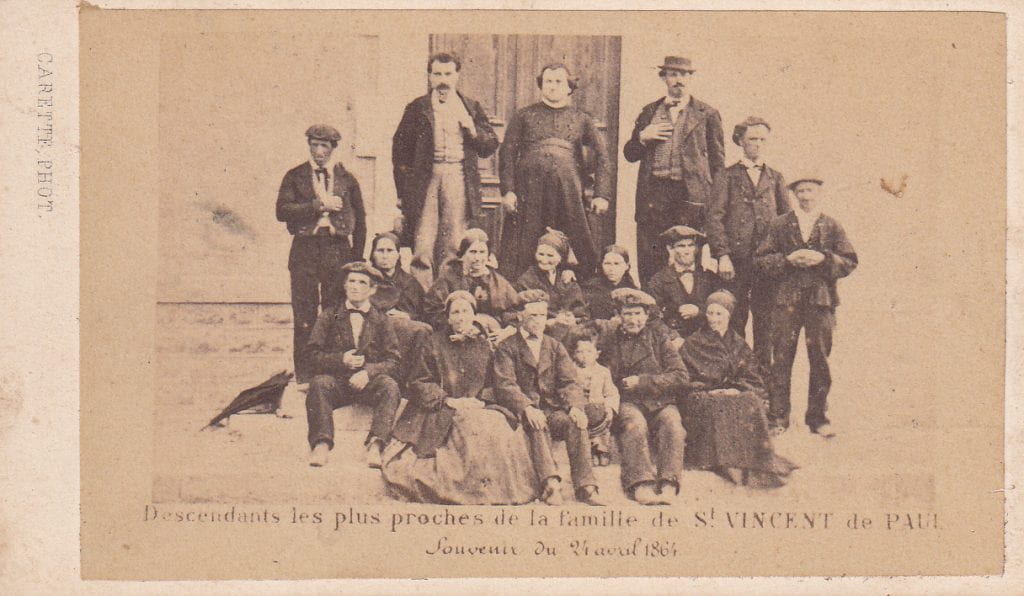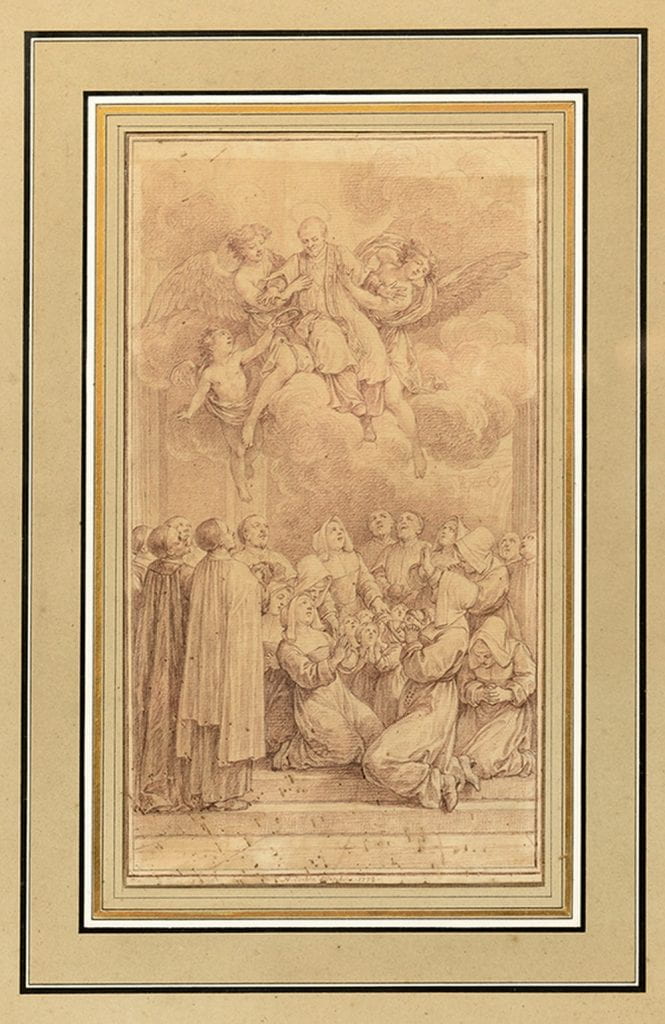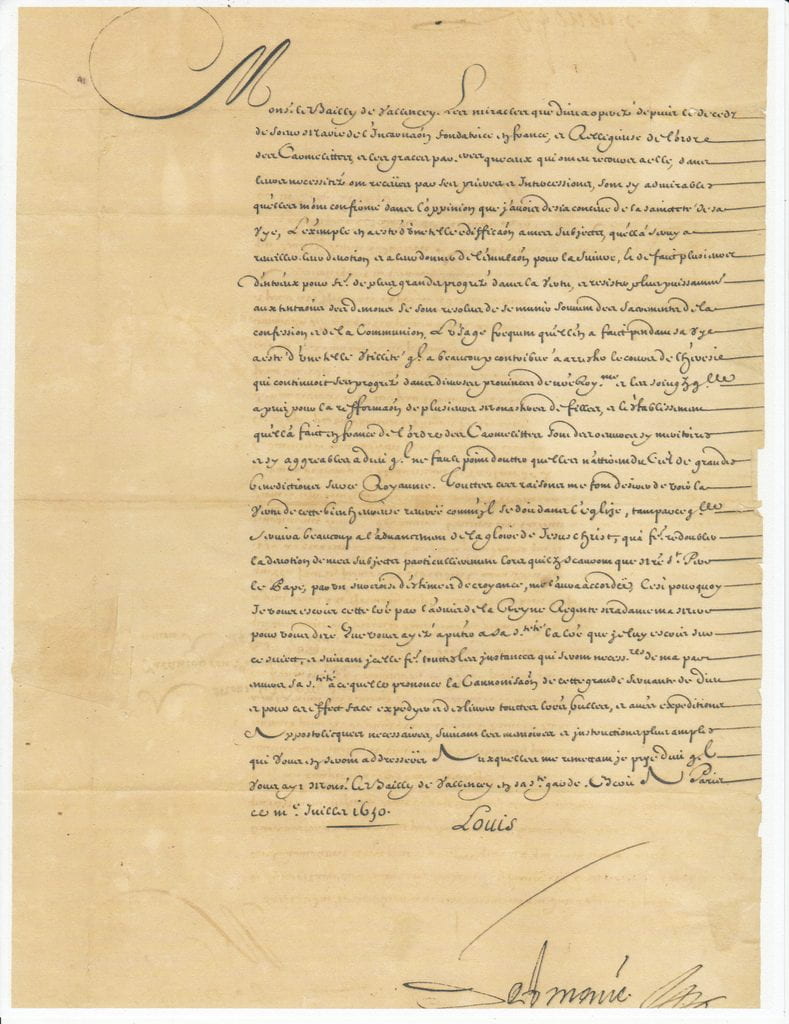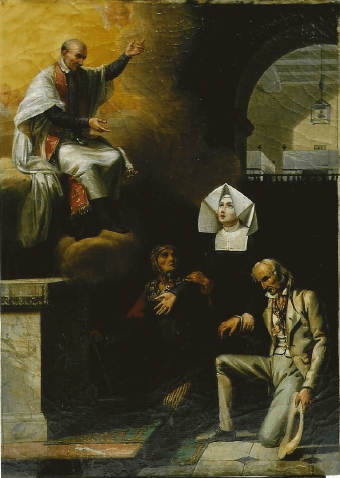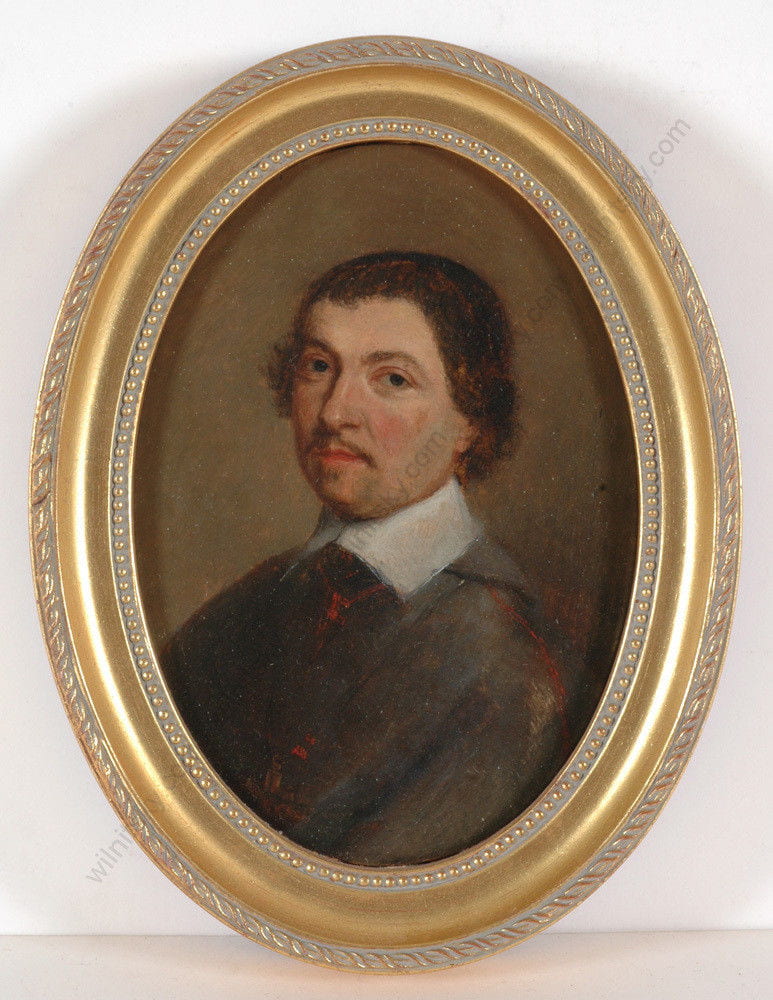This rare carte-de-visite is a souvenir of the dedication of the saint’s birthplace shrine in April 1864. The elderly woman seated on the step in the lower right hand of the picture was also featured in a separate photo as the oldest living descendant.
Vincentian History
Newsnote: Rare Vincent de Paul engraving acquired
The Vincentian Studies Institute has acquired a rare 18th century engraving of the apotheosis of Vincent de Paul. See the auction description below:
Description: COCHIN, Charles-Nicolas II [Assumption of St. Vincent de Paul]. 1772 Sanguine chalk, laid paper 26 x 14,5 cm; signed “C.N. Cochin filius delin.” and dated in lower margin (recto sl. and irregularly browning, verso sl. browning, faint stain at lower part with one tiny unobtrusive hole). Framed under glass (unframed). Beautiful finely achieved scene picturing the Saint carried away in the air by 3 gracious angels under the eyes of a number of clergymen, nuns and children. One of the drawings executed by Cochin (1715-1790) for the “Evangeliorum ad usum Capellae Regiae”, a prayer book for the Versailles Royal Chapel. On verso label of the Belgian expert Jean Willems according to whom this drawing is mentioned in Goncourt, “L’art au XVIIIe s.”, vol. II, n. 774: “10 sanguines non gravées, des compositions pour le Missel de la Chapelle du Roi”. Ref. Christian Michel, Charles-Nicolas Cochin et le livre illustré au XVIIIe s., 1987, 163 (bi). Prov. Auction Drouot, 9/2/1972.
Newsnote: Holy Card of Marguerite Naseau acquired
This holy card is an unusual depiction of Marguerite Naseau (the “first” Daughter of Charity). This image is much more realistic than the traditional image of Marguerite as a young beauty queen. The card is from Belgium and dates from the first half of the 20th century. The Vincentiana collection at DePaul University’s Archives and Special Collections has now added this card to its extensive collections. The quotation from St. Vincent de Paul at the bottom of the card is translated: “I do not remember ever seeing her without being edified.”
Newsnote: Louis XIV manuscript letter is acquired.
The Vincentiana Collection of Archives and Special Collections at DePaul University has recently acquired a July 1650 manuscript letter of Louis XIV to his ambassador in Rome supporting the canonization of the famous Barbe Acarie or as she was known in her Carmelite convent: Soeur Marie de l’Incarnation.
Transcription, Translation, and Annotation below.
Thanks to Matthieu Brejon and John Rybolt for their assistance.
Transcription
[Louis XIV to Valencey] Mons[ieur] le Bailly de Vallencey. Les miracles que Dieu a operez depuis le décédz de Sœur Marie de l’Incarnaton, fondatrice en France et religieuse de l’ordre des Carmelites, et les graces particulières que ceux qui ont eu recours à elle dans leurs nécessités ont receues par ses prieres et intercessions sont sy admirables qu’elles m’ont confirmé dans l’oppinion que j’avais déjà conçue de la sainteté de sa vye. L’exemple en a été d’une telle édiffication à mes subjects qu’elle a servi à raviver leur devotion et à leur donner de l’emulation pour la suivre, et de faict plusieurs d’entre eux pour faire de plus grands progrez dans la vertu et resister plus puissamment aux tentations des demons se sont resolus de se munir souvent des sacrements de la confession et de la communion. L’usage fréquent que l’on en a faict pendant sa vye a été d‘une telle utillité qu’il a beaucoup contribué a arrester le cours de l’heresie qui continuoit ses progrez dans diverses provinces de nostre Royaume et les soingz quelle a pris pour la refformation de plusieurs monasteres de filles, et l’establissement qu’ell’a faict en France de l’ordre des Carmelittes sont desormais sy meritoires et sy aggreables à Dieu qu’il ne faut point doutter qu’ils n’attirent du Ciel de grandes benedictions sur ce Royaume. Touttes ces raisons me font desirer de voir la vertu de cette bienheureuse reçue comme il se doit dans l’Eglise, tant par ce qu’elle servira beaucoup à l’advancement de la gloire de Jesus Christ, qui fera redoubler la devotion de mes subjects particullierement lorsqu’ilz scauront que nostre Saint Père le Pape, par un surcroise d’estime et de croyance, me l’aura accordëe. C’est pourquoy je vous escris cette lettre par l’advis de la Reyne Regente madame ma mere pour vous dire que vous ayez à presenter à sa sainteté la lettre que je luy escris sur ce suiect et, suivant icelle, faire touttes les instances qui seront necessaires de ma part et amener sa sainteté à ce qu’elle prononce la Cannonisation de cette grande servante de Dieu et pour cet effect qu’on face expedyer et deslivrer touttes les bulles et autres expeditions appostoliques necessaires, suivant les memoires et instructions plus amples qui vous en seront addressëes. Auxquelles me remettant je prye Dieu qu’il vous aye, Monsieur le Bailly de Vallencey, en sa sainte garde. Escrit à Paris ce mois de Juillet 1650. Louis [Side 2] [Addressed] A Mons[ieur] le Bailly de [Vallenc]ey con … cou.els […] a Rome. Monsieur le Bailly de Valancey.
English Translation
The miracles which God has granted since the death of Sister Marie de l’Incarnation, religious, and founder in France of the order of the Carmelites, and the graces which have been received by those who have prayed for her intercession are so admirable that they have confirmed the opinion I had already formed of the sanctity of her life. Her holy example has provided great edification to my subjects who in their devotion have sought to follow her example and vowed to make great progress in virtue by strongly resisting the demons which so resolutely try to distract them from the sacraments of confession and communion. The example of the frequent usage she made of these sacraments in her life has greatly contributed to stop the spread of the heresy which has grown in various provinces of our Kingdom. The great care that she took to reform so many monasteries of women and the establishment which she made in France of the Order of Carmelites are so meritorious and pleasing to God that it is beyond doubt that these actions have attracted Heaven’s blessing upon Our Kingdom. All of these reasons have led me to wish that the virtue of this blessed religious will be recognized by the Church and thus greatly contribute to the advancement of the glory of Jesus Christ and in particular to increase the devotion and esteem of my subjects for our Holy Father the Pope. It is for this reason, at the advice of the Queen-Regent, my mother that I am writing you on this subject. Do all that you can on my behalf to urge His Holiness to canonize this great servant of God. In order to accomplish this please forward all the bulls and other necessary Apostolic documents following the detailed instructions which I am sending to you. I pray that God will preserve you Monsieur le Bailly de Valancey. From Paris this month of July 1650. LOUIS
Blessed Marie de l’Incarnation (Barbe Acarie) (1566-1618). One of the key spiritual figures of the famous l’age d’or (age of gold) which provided the basis for the reform of the French Catholic church at the dawn of the 17th century. A noble widow, and mother of seven children Madame Acarie belonged to the circle of the dévots in France. She helped to bring to France the Discalced Carmelites founded by Teresa of Avila (1603). She also played a role in the founding of the French Oratory of Jesus with her cousin Pierre de Berulle, as well as bringing the Ursulines to France. She was renowned for her charity, mysticism, and zeal for the faith. After the death of her husband in 1614 she entered the Carmel at Amiens as a lay sister. She died in 1616. She was beatified by Pius VI in 1791,
Henri d’Estampes-Valençay (1603-1678) as a child was enrolled in the order of Saint John of Jerusalem (the Order of Malta). He rose to the high position of bailiff in the order. He was a knight, and successively served as the commander in Metz, general in chief of the French navy, and general of the galleys of Malta. He served as French ambassador to the Holy See from 1652 to 1654, then as ambassador to Venice. He rose in positions of leadership and prominence in the Order of Malta. His desire for a cardinal’s hat was frustrated by the promotion of Jean-François de Gondi the Cardinal de Retz as coadjutor to his uncle, the archbishop of Paris. Valencay died in Malta in 1678.
The Coste edition of Vincent de Paul’s Correspondence, Conferences and Douments, records one letter of the saint to him in November 1653 (Volume 5, pg 54). There are two other mentions of the ambassador. (Volume 4, pgs. 271 and 585).
Louis XIV (1638-1715) at age 5 succeeded his father Louis XIII to the throne of France. His mother Anne of Austria (1601-1666) served as regent from 1643 to 1651 when at age 13 the king reached his majority. The Queen and Cardinal Mazarin continued to play key roles in the kingdom until the king undertook his personal rule in 1661 after Mazarin’s death.
Newsnote: New Volume of Ozanam Correspondence
 Correspondance Frédéric Ozanam et Amélie Soulacroix Poèmes, prières et notes intimes Léonard de Corbiac (Textes rassemblés par) Magdeleine Houssay (Avec la contribution de) Présentation : Cette édition de la correspondance entre Amélie Soulacroix et Frédéric Ozanam réunit en un seul document les deux voix du couple, les lettres d’Amélie jusque-là inédites et celles de Frédéric, déjà publiées. On connaît Frédéric Ozanam : le principal fondateur de la Société de Saint-Vincent-de-Paul, le serviteur de la Vérité, le défenseur de la question sociale, celui qui s’agenouillait devant les pauvres, « images sacrées de ce Dieu que nous ne voyons pas ». Mais on redécouvre l’homme, l’amoureux, le père, l’universitaire, le poète, un homme plus simple, sans autres fards que ceux de son éloquence. Amélie nous était jusque-là presque inconnue : cette correspondance fait sortir de l’ombre une femme attachante par sa simplicité et son naturel, étonnante par ce qu’elle révèle à la fois d’elle-même mais aussi de Frédéric, véritable compagne qui a fait avec lui ce cheminement vers la sainteté. Par-delà ce regard intime qui éclaire une facette plus secrète d’un homme public, c’est un amour conjugal qui se découvre, sans pour autant être indiscret. Comme l’écrit Xavier Lacroix : « ce qu’expriment Frédéric et Amélie est tellement beau, Vrai surtout, juste, que cela en quelque sorte, par le haut, ne leur appartient plus. Le Vrai est universel. Il exprime une vérité de l’humain qui est en chacun de nous. » Don Léonard de Corbiac est prêtre de la communauté Saint-Martin, vicaire en paroisse à Biarritz. Il a consacré ses travaux universitaires de mémoire à Frédéric et surtout à Amélie Ozanam. Date de parution : 16.08.2018 EAN : 9782220095301 Nombre de pages : 864
Correspondance Frédéric Ozanam et Amélie Soulacroix Poèmes, prières et notes intimes Léonard de Corbiac (Textes rassemblés par) Magdeleine Houssay (Avec la contribution de) Présentation : Cette édition de la correspondance entre Amélie Soulacroix et Frédéric Ozanam réunit en un seul document les deux voix du couple, les lettres d’Amélie jusque-là inédites et celles de Frédéric, déjà publiées. On connaît Frédéric Ozanam : le principal fondateur de la Société de Saint-Vincent-de-Paul, le serviteur de la Vérité, le défenseur de la question sociale, celui qui s’agenouillait devant les pauvres, « images sacrées de ce Dieu que nous ne voyons pas ». Mais on redécouvre l’homme, l’amoureux, le père, l’universitaire, le poète, un homme plus simple, sans autres fards que ceux de son éloquence. Amélie nous était jusque-là presque inconnue : cette correspondance fait sortir de l’ombre une femme attachante par sa simplicité et son naturel, étonnante par ce qu’elle révèle à la fois d’elle-même mais aussi de Frédéric, véritable compagne qui a fait avec lui ce cheminement vers la sainteté. Par-delà ce regard intime qui éclaire une facette plus secrète d’un homme public, c’est un amour conjugal qui se découvre, sans pour autant être indiscret. Comme l’écrit Xavier Lacroix : « ce qu’expriment Frédéric et Amélie est tellement beau, Vrai surtout, juste, que cela en quelque sorte, par le haut, ne leur appartient plus. Le Vrai est universel. Il exprime une vérité de l’humain qui est en chacun de nous. » Don Léonard de Corbiac est prêtre de la communauté Saint-Martin, vicaire en paroisse à Biarritz. Il a consacré ses travaux universitaires de mémoire à Frédéric et surtout à Amélie Ozanam. Date de parution : 16.08.2018 EAN : 9782220095301 Nombre de pages : 864
Newsnote: New Elizabeth Seton Biography Published
In 1975, two centuries after her birth, Pope Paul VI canonized Elizabeth Ann Seton, making her the first saint to be a native-born citizen of the United States in the Roman Catholic Church. Seton came of age in Manhattan as the city and her family struggled to rebuild themselves after the Revolution, explored both contemporary philosophy and Christianity, converted to Catholicism from her native Episcopalian faith, and built the St. Joseph’s Academy and Free School in Emmitsburg, Maryland. Hers was an exemplary early American life of struggle, ambition, questioning, and faith, and in this flowing biography, Catherine O’Donnell has given Seton her due. O’Donnell places Seton squarely in the context of the dynamic and risky years of the American and French Revolutions and their aftermath. Just as Seton’s dramatic life was studded with hardship, achievement, and grief so were the social, economic, political, and religious scenes of the Early American Republic in which she lived. O’Donnell provides the reader with a strong sense of this remarkable woman’s intelligence and compassion as she withstood her husband’s financial failures and untimely death, undertook a slow conversion to Catholicism, and struggled to reconcile her single-minded faith with her respect for others’ different choices. The fruit of her labors were the creation of a spirituality that embraced human connections as well as divine love and the American Sisters of Charity, part of an enduring global community with a specific apostolate for teaching. The trove of correspondence, journals, reflections, and community records that O’Donnell weaves together throughout Elizabeth Seton provides deep insight into her life and her world. Each source enriches our understanding of women’s friendships and choices, illuminates the relationships within the often-opaque world of early religious communities, and upends conventional wisdom about the ways Americans of different faiths competed and collaborated during the nation’s earliest years. Through her close and sympathetic reading of Seton’s letters and journals, O’Donnell reveals Seton the person and shows us how, with both pride and humility, she came to understand her own importance as Mother Seton in the years before her death in 1821. Hardcover: 552 pages Publisher: Three Hills (September 15, 2018) Language: English ISBN-10: 1501705784 ISBN-13: 978-1501705786
Newsnote: “L’Hospital General Charitable a Paris.” 1657 work acquired
The Vincentiana Collection at DePaul Universit’s Archives and Special Collections Department has recently acquired a copy of the 1657 announcement about the establishment of the Hospital General of Paris. This controversial institution sought to assist the masses of the urban poor in Paris, but to do so only by depriving the poor of their liberty. The King, Archbishop of Paris and Parlement announced that the Lazaristes and Daughters of Charity would have spiritual responsibility for the institution. However, they had not consulted Vincent de Paul. After consultation Vincent would graciously decline the offer citing a paucity of confreres and sisters. See for example Coste, CCD: 6:257-258, 268-269, 274-275. The booklet had announced: “Les Peres Missionnaires de saint Lazare dont l’on scait assez la grace, ont este establis pour avoir soin du spirituel, sous l’autorite de Monseigneur l’Archevesque de Paris, & les filles de la Communaute de Madamoiselle le Gras, dont la bonne conduite est aussi connue, one este acceptees por le service du sexe.”
Newsnote: 19th century Vincentian painting acquired
The Vincentiana collections at DePaul University’s Archives/Special Collections has acquired a 19th century Vincentian painting by the artist Andre-Joseph Bodem. (1791-1830?) Believed to have been a commission for l’hopital Saint-Joseph in Compeigne, France run by the Daughters of Charity. The hospital was built in the second quarter of the 19th century. The painting is in a hospital setting. In the background right a ward with numbered beds can be seen. Many of these pre-modern religious hospitals would have separate wards for men and women. The wards would flank the chapel. At mass and other prayer times the curtain separating the wards would be pulled back so that the patients could see and hear the religious services. This hospital chapel had an altar dedicated to Saint Vincent de Paul. The Daughters of Charity is flanked by a representative old woman and man. They surely represent the hospital’s patients. The dress of the couple supports a c. 1825 date for the painting. Bodem’s records indicate commissions for several paintings of Saint Vincent de Paul. One in particular is identified for the hospital at Compeigne. Our presumption is that this is that painting. Dimensions: Height: 18.5″ Width: 13.25″ The painting was restored by Faye Wrubel of “2 Preserve Arts, Inc.”
Newsnote: Dutch carving of Saint Vincent de Paul acquired. Artist: Johannes Petrus Maas
The Vincentiana Collection at the Archives & Special Collections Department of DePaul University’s John T. Richardson Library recently acquired a carved oak statue of Vincent de Paul with a foundling. The work by the Dutch artist Johannes Petrus Maas (1861-1941) is 21 inches tall. It joins the extensive Vincentian statuary collection at the university.
Newsnote: Early Portrait of the Cardinal de Retz (Jean-Francois Paul de Gondi) acquired
The Vincentiana Collection at the Archives and Special Collections of DePaul University’s John T. Richardson Library has recently acquired a portrait of Jean-Francois Paul de Gondi the famous Cardinal de Retz (1613-1679) The Cardinal, who knew Vincent de Paul from his birth served as archbishop of Paris from 1654-1662. He was a famous Frondeur and memorist. The portrait is attributed to the Dutch painter Jan de Bray (1630-1697).
